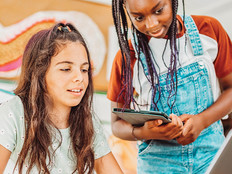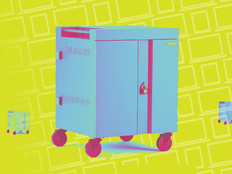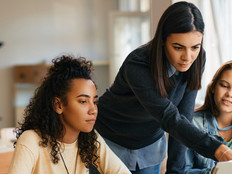Districts Save Money With Digital Textbooks
Do you want to see the future of education? It's happening now at Ohio's Lorain City Schools, where administrators have replaced traditional textbooks with e-books.
Instead of distributing print textbooks at the start of each school year, the district equips its middle and high school students with netbooks, whose hard drives come preloaded with the digital equivalent of every text the students will need.
“The e-books are interactive, save the district money and are lighter,” says CIO Gary Brantley. “We didn't want our kids – especially the younger ones – to have to carry six to seven textbooks to and from school anymore.”
Lorain City Schools joined the e-book movement early on. But two years later, digital textbooks continue to account for a mere fraction of the overall K–12 textbook market.
@EdTech
To learn how digital textbooks are enlivening the classroom experience for Lorain Admiral King High School's students, go to edtechmag.com/k12/history310.
Adoption of the technology most likely will accelerate as older textbooks need to be replaced and as administrators continue to look to trim costs. Other trends are driving e-books' growth as well, including the expansion of one-to-one computing programs in schools; the general public's increasing acceptance of e-books; and an influx of affordable, handheld digital reading devices, including e-book readers, tablets and smartphones.
Educators and analysts argue that digital textbooks improve the learning process because they engage a tech-savvy generation of students in interactive, multimedia lessons. By combining reading with audio and video clips, interactive graphics, and virtual labs and simulations, e-books not only help students understand concepts faster, they make students want to learn.
“E-books are the future,” says Yankee Group analyst Dmitriy Molchanov. “Today's traditional textbooks are just text and pictures, but with e-books you can embed video and audio streams. It's a new-media approach to learning that makes it a lot easier for kids to learn.”
Cost savings aren't a given because schools must first invest in e-book reading devices. But e-books can save money in the long run if they're implemented under the right circumstances. Some early adopters have negotiated lower prices for digital texts in their schools. And some states – California and Texas among them – are beginning to embrace free, open-source e-textbooks.
Instead of paying $181,876 for paper-based math books to replace worn and outdated editions, Lorain City Schools paid $15,267 for electronic versions.
Going digital also simplifies the book distribution process, minimizes storage requirements and eliminates the need to replace lost or damaged print textbooks, reducing costs even further. What's more, e-books can be easily updated by publishers to give students the most current content. Paper texts, by comparison, are typically used for at least five years before they're replaced.
How are schools integrating e-books into their curricula? And what types of results are they achieving? As is the case with most nascent technologies, the answers vary by school and by circumstance.
Reading E-Books on Netbooks
Lorain City Schools, a district with about 9,000 students in Lorain, Ohio, implemented its e-book and one-to-one computing initiatives simultaneously – and saved a good deal of money in the process.
In 2008, the district had to replace its aging textbooks, so Superintendent Dr. Cheryl Atkinson asked Brantley and Maria Sanchez, deputy superintendent for teaching and learning, to explore e-books as an alternative. When they called the district's book publishers inquiring about digital options, the publishers were caught off guard.
At the time, the publishers were developing electronic textbooks, but they didn't have pricing or distribution models in place. Today, e-book publishers track book licenses by providing students with user names and passwords. But back then, they had no method for monitoring how schools distributed digital copies of books.
District officials used that limitation to their advantage. They called their publishers' sales reps, who hemmed and hawed. They continued to push until they got meetings with the publishers' vice presidents.
Atkinson told them “that if they couldn't do it, we would find someone who could,” Brantley recalls. The publishers didn't want to lose out on the sales opportunity, so once the first publisher struck a deal with the district, the others quickly followed. By August 2008, Lorain City Schools had digital versions of every book it used to teach core subjects.
Students access the e-books using low-cost Acer netbooks that Brantley purchased. The district issued all 5,300 devices, which came with warranties, to middle and high school students and their teachers.
Most students attending district schools live in poverty, so it was important for administrators to give the older students computers they could take home and to provide them with Wi-Fi access while at school.
“Our students are not only comfortable with their laptops and the use of the e-books, they are now able to compete with their peers,” Atkinson says. “Everyone has equal access.”
According to Brantley, Lorain City Schools spent $1.8 million on the two initiatives – about $1.1 million for the e-books and another $700,000 on the netbooks. If the district had continued using paper textbooks, it would have spent $3 million. Together, e-books and netbooks saved the district $1.2 million.
Some publishers make their books available online, but many students don't have Internet access at home; so the district installed every textbook that students would need onto their netbooks. The publishers delivered the e-books in different ways. Some sent CDs; others uploaded executable files via FTP.
Brantley and his staff, who expect the netbooks to last four to five years, keep track of each netbook using barcode stickers. Students turn in the netbooks at the end of the school year so IT technicians can perform maintenance and reimage them for the upcoming year.
“We reimage them because the students may have downloaded content that makes the netbooks sluggish,” Brantley explains. “So we personally touch every machine and wipe them completely.”
Going the E-Reader Route

Michael Rea says Rancho Christian currently owns a mix of first- and second-generation Sony Readers. Ninth-grade students use the Reader Pocket Edition; 10th-graders work with the larger Reader Touch Edition.
Photo: Thomas Michael Alleman
When Rancho Christian, a private K–12 school in Temecula, Calif., opened its high school two years ago, administrators wanted a liberal arts curriculum that emphasized primary- and secondary-source literature, rather than relying on textbooks.
They considered compiling their own anthologies of historical works, but they ultimately deemed the effort too time intensive, costly and restrictive (the anthologies would have given students excerpts rather than complete titles). Around that same time, administrators happened to spot an advertisement for Sony's e-book reader and realized it was the answer to their dilemma.
“We got excited because we could download a lot of stuff in the public domain for free,” says Michael Rea, Rancho Christian's superintendent and acting high school principal. “That alone would bring the cost way down for us. Plus, we thought the technology would encourage students to read.”
The students devoured so many books that, within a month or two, they asked for more. In response, the school built a virtual library of several hundred books, which the librarian downloaded to the students' e-readers.
Rancho Christian purchased Sony Readers for all 30 ninth- and 10th-grade students and for 10 teachers to use on and off premises. The librarian manages the devices and uses a USB cable to connect the e-readers to a computer. Through simple dragging and dropping, she can download hundreds of books in just a few minutes, Rea says. At the end of each school year, the librarian retrieves the e-readers from students, reformats the devices and loads the coming year's books.
The Sony Reader supports several file formats, including EPUB (electronic publication), the XML-based industry standard developed by the International Digital Publishing Forum; Microsoft Word; and Adobe PDF, thus ensuring compatibility with a wide range of materials. Rea says the school's users also appreciate the device's e-paper display technology, which doesn't emit light in the same way standard VGA or LCD screens do (and therefore doesn't cause eye strain).
The school's ninth-graders are reading classic literature, such as Homer's Odyssey, while sophomores are reading European titles, including Shakespeare's Romeo and Juliet. Rea says administrators found nearly all of their e-books using free sites, such as Project Gutenberg and Google Books. They did have to buy a few books, though, and will buy more when the current sophomore class begins studying 20th-century literature during their senior year.
The e-readers are paid for as part of the students' tuition. The school expects each device to last two years, but purchased two-year warranties to cover any damage.
And the devices – particularly the screens – do get damaged. “It seems that any pressure on the screen, like a pencil pushing on the front while the device is in a student's backpack, would cause damage and we'd have to send it [out] for repairs,” Rea says.
Despite such quibbles, school administrators are happy with the devices and will move forward with e-books. “The e-readers have increased our students' interest in reading,” Rea says. “And the technology encouraged it.”
Engaging Approaches
Because it operates as an online school, the Clark County School District Virtual High School in Las Vegas standardized on digital textbooks. Principal Essington Wade says the school's 6,000 students access their web-based texts by logging in to a learning management system. One or two textbooks are still presented as PDFs of regular print textbooks, but most are multimedia-rich.
Giving students 24x7 access to their online textbooks and coursework is valuable. “It's important to extend the school day,” Wade says, “and that's what online learning and these electronic tools do for us.”
For the past five years, Florida's Broward County Public Schools has taken a hybrid approach, providing its 255,000-plus students with both print and electronic textbooks. Administrators say the solution is a win-win because it gives students the ability to read their print textbooks at school and to access the same content at home via the district's web portal.
@EdTech
For more about Lorain City Schools' one-to-one netbook program, go to edtechmag.com/k12/netbook309.
The Broward Enterprise Education Portal's four “digital doorways” point students, teachers, parents and administrators to other online learning resources as well, including podcasts and reference tools. “Our district wants to deliver instruction in ways that are more meaningful, relevant and engaging for our students,” says Michele Rivera, the district's director of learning resources and instructional materials. “We pride ourselves on that.”
Together, Forever?
E-books might be publishing's future, but don't count out print textbooks just yet.
Rivera believes most districts will adopt a model similar to the one in place in Broward County. She sees this happening for two reasons: Building the proper technology infrastructure to support digital content in every school is a complex and expensive process, and not every family has Internet connectivity.
Lorain City Schools hasn't completely done away with traditional texts either. According to Brantley, existing copies remain available for classroom use. But the e-books serve as the students' primary source of reading material – and it seems to suit students, parents and teachers just fine, says Diane Conibear, principal of Lorain Admiral King High School. “We have to adapt our instruction to what's happening in society,” she says. “Our kids are living in the technology age, and these tools are what engage their learning.”
Blazing a New Trail
Oregon is trying out e-textbooks by allowing school districts to buy Discovery Education's online science instructional materials for elementary and middle school students. The state's Board of Education announced last October that Discovery's online materials met state science standards.
According to Kelli Campbell, Discovery Education's senior vice president of global product and content strategy, numerous Oregon school districts are currently using the company's digital instructional materials on a trial basis and are considering them as paper textbook replacements for the 2010–2011 school year.
Discovery Education's multimedia web-based coursework includes reading passages, video and audio clips, and interactive virtual labs and simulations. Interactive features allow students to run simulations of earthquakes and volcanoes, for example, or conduct virtual science labs.
Campbell estimates that Discovery Education's digital materials cost about 25 percent to 30 percent less than paper textbooks. “We think the differentiated instruction and support for different learning modalities will help students succeed,” she adds.
E-Books Made Easy
Gary Brantley, CIO of Lorain City Schools, offers these best practices for successfully integrating electronic textbooks into the curriculum:
- Make sure the school district can sustain e-book funding. Once you make the switch, it's hard to go back to print textbooks. Lorain City Schools uses federal grant money to pay for its netbook computers and for professional development.
- If you want to migrate to e-books, make sure your technology committee includes an e-book reading device in the technology plan. It is easier to have the devices approved during the budgeting process if they are already preapproved by IT, are part of the district's future plans and have the support of the district's stakeholders, including administrators and teachers.
- When equipping students with a netbook, regular notebook or e-reader device, hold an orientation for students and parents. Teach students how to use and care for the device. Have parents sign an acceptable-use policy and a permission form that allows students to use the device.
- Provide professional development courses to teachers. This will help them incorporate the reading devices and electronic textbooks into their classroom instruction.
- Buy the extended warranty for your e-reading device. When Lorain City Schools' Acer netbooks need repairs, including new screens, the IT staff sends them back to the manufacturer, who fixes them within a few days.







